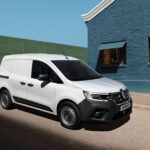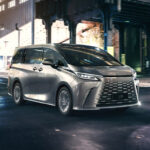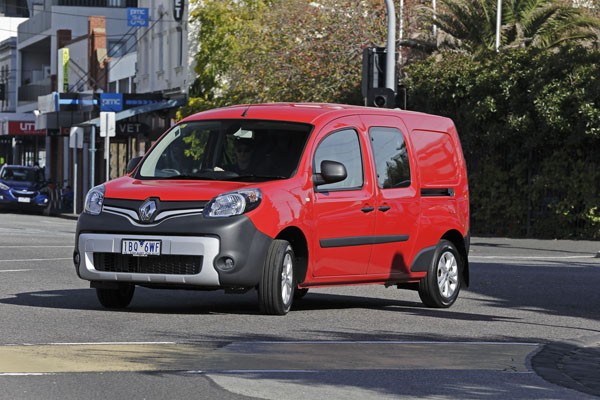 Renault Kangoo is a small-to-medium van that has been the best-selling vehicle in its class in Europe for many years. These days Australians tend to prefer larger vans, though we have bought smaller units in the past. Renault Australia is keen to change this situation so has recently expanded the Kangoo van range with the introduction of a four-door crew-cab called Kangoo Maxi Crew.
Renault Kangoo is a small-to-medium van that has been the best-selling vehicle in its class in Europe for many years. These days Australians tend to prefer larger vans, though we have bought smaller units in the past. Renault Australia is keen to change this situation so has recently expanded the Kangoo van range with the introduction of a four-door crew-cab called Kangoo Maxi Crew.
Obviously the Kangoo Crew doesn’t have to be a working van with extra seats for the crew; it can also be used as a well-priced people mover for those with families who need to cart a lot of gear – if that’s not a tautology!
This is an attractive package at a reasonable price and after spending a week road testing a Kangoo we really grew to like it.
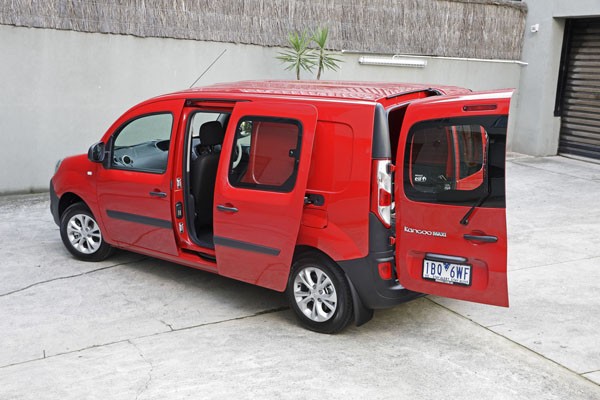
STYLING
We love the name Kangoo, and rejoice in the fact that Renault’s French rival Peugeot calls its Kangoo competitor the Jumper. Great fun, and something that’s not always the norm in the heavy-duty world of commercial vehicles.
Renault Kangoo has a short, rounded bonnet fronted up by a large pedestrian-friendly bumper. Boldly shaped wheel arches and merging styling lines give the new Kangoo a modern look.
If you’ve ever witnessed the hit-and-miss (often hit!) driving and parking in European cities you will understand why Renault Kangoo’s front guards are made from a material called Noryl. This is a supple composite material that is able to absorb small to medium bumps, it’s also easy to remove and replace the panels if they are badly damaged.
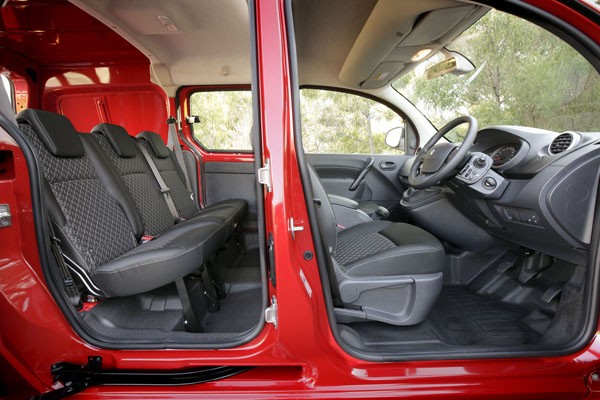 INSIDE
INSIDE
Renault Maxi Crew’s rear passenger doors are van-type sliding units on both side and we found entry and egress very simple due to the seats being higher than in a passenger car. There are five seats and all can take a normally size adult with no compromises in comfort. The seats are covered in hardwearing cloth trim
A big advantage of being van-based is that the Kangoo still has plenty of space for cargo even if the rear seats are in use.
The rear seats have plenty of legroom, headroom looks high enough to allow clouds to form up there! It has a 67/33 split and the backrest can be folded to provide a completely flat floor.
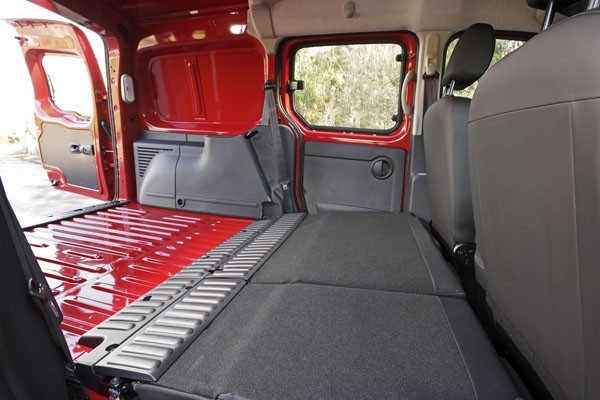 With the seats down, up to 4000 litres of cargo can be carried. When the back seats are in use the capacity is still 1300 litres – way better than the average people mover or SUV of this size.
With the seats down, up to 4000 litres of cargo can be carried. When the back seats are in use the capacity is still 1300 litres – way better than the average people mover or SUV of this size.
Items up to 2880 mm in length can be carried inside if the front passenger seat is folded forward. Loads of up to 1218 mm wide will fit between the rear wheel arches. The asymmetrically split rear doors open through 90 and then 180-degrees. However, they can’t be taken back to 270 degrees to permit reversing into tight loading bays.
Maximum load rating is 710 kg.
Standard features include Bluetooth connectivity and cruise control with a speed limiter, air conditioning and power front windows
ENGINE / TRANSMISSION
A new design turbo-diesel engine is significantly better than the one in the previous Kangoo Maxi. It still has a capacity of 1.5 litres, but now puts out 81 kW of power and 240 Nm of torque. It’s mated to a six-speed manual gearbox.
There’s no automatic transmission option, Renault Australia is well aware this will hurt sales and has made strong representations to office in France to come up with a self shifter beside this diesel.
SAFETY
Bad news here. Only two airbags are fitted as standard, you have to pay an additional $490 for side airbags to be fitted in the rear seats. Likewise a modular cargo barrier will add $1490 to the price. Renault Kangoo received a four-star crash test rating after European NCAP testing.
DRIVING
Renault Kangoo’s new diesel engine is more than happy to climb hills in high gears and lope along with minimum fuel consumption on the flat. The gearchange action is light and smooth and having six ratios mean motorway and country driving in top gear is relaxing.
Typically we used between six and seven litres per hundred kilometres in easy running conditions. It will come down into the high fives if you really try. Around town consumption will generally be in the seven to eight litres per hundred kilometres bracket.
Engine noise from the turbo-diesel is impressively low.
As it’s based on a passenger car platform (from the Renault Scenic people mover) the Kangoo rides in a comfortable manner and makes light work of rough Aussie backroads. However, road noise is very evident on anything but the smoothest of surfaces and we found ourselves winding the radio well up to stop it being drowned out. It’s a van, not a car so this is perhaps understandable, but try before you buy if you’re looking for a passenger carrier.
Handling isn’t a feature that’s usually demanded by Australian van drivers, but our French cousins do like to hammer along, so there’s a lot more road grip than you might anticipate.
This is a sophisticated van, not a dedicated people mover or SUV so you don’t have the same degree of comfort interior finish or quality you would expect in them.
SUMMING UP
The Kangoo comes with a factory three-year warranty that stretches to an impressive 200,000 kilometres. There’s also three years free roadside assistance as well as capped price servicing for $349 per calendar year for the first three years.




